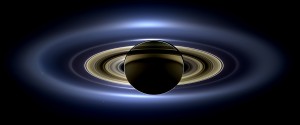
The full set of rings, imaged as Saturn eclipsed the Sun from the vantage of the Cassini spacecraft. Earth is visible as a “pale blue dot” at about the 4 o’clock position. From http://en.wikipedia.org/wiki/Rings_of_Saturn.
For our inaugural journal club at BSU physics, we discussed a very interesting paper led by Prof. Matt Hedman, now at University of Idaho Physics.
Hedman and Nicholson studied subtle density perturbations in Saturn’s ring system. If you look at images of the rings, you’ll see lots of patterns, many of which are caused by gravitational interactions with Saturn’s many satellites — the inner edge of the Cassini division, for example, is sculpted by gravitational tugs from Mimas.
However, the ring patterns studied by Hedman and Nicholson seem to result from gravitational perturbations with periods much shorter than the orbital periods of any Saturnian satellite, meaning the satellites aren’t the cause.
The periods actually correspond to those expected for oscillations within Saturn itself. Just like stars exhibit oscillations, Saturn oscillates, producing periodic variations in its gravitational field. And, as for stars, the periods of these oscillations depend on its interior. So by studying these subtle ring patterns, Hedman can tease out information about Saturn’s internal structure.
Hedman has coined the term “Kronoseismology” for this new approach to studying Saturn’s interior, analogous to “asteroseismology” for stars and “seismology” for the Earth. And just like those fields, Kronoseismology promises to lead to profound new insights about the second biggest planet in our solar system.
